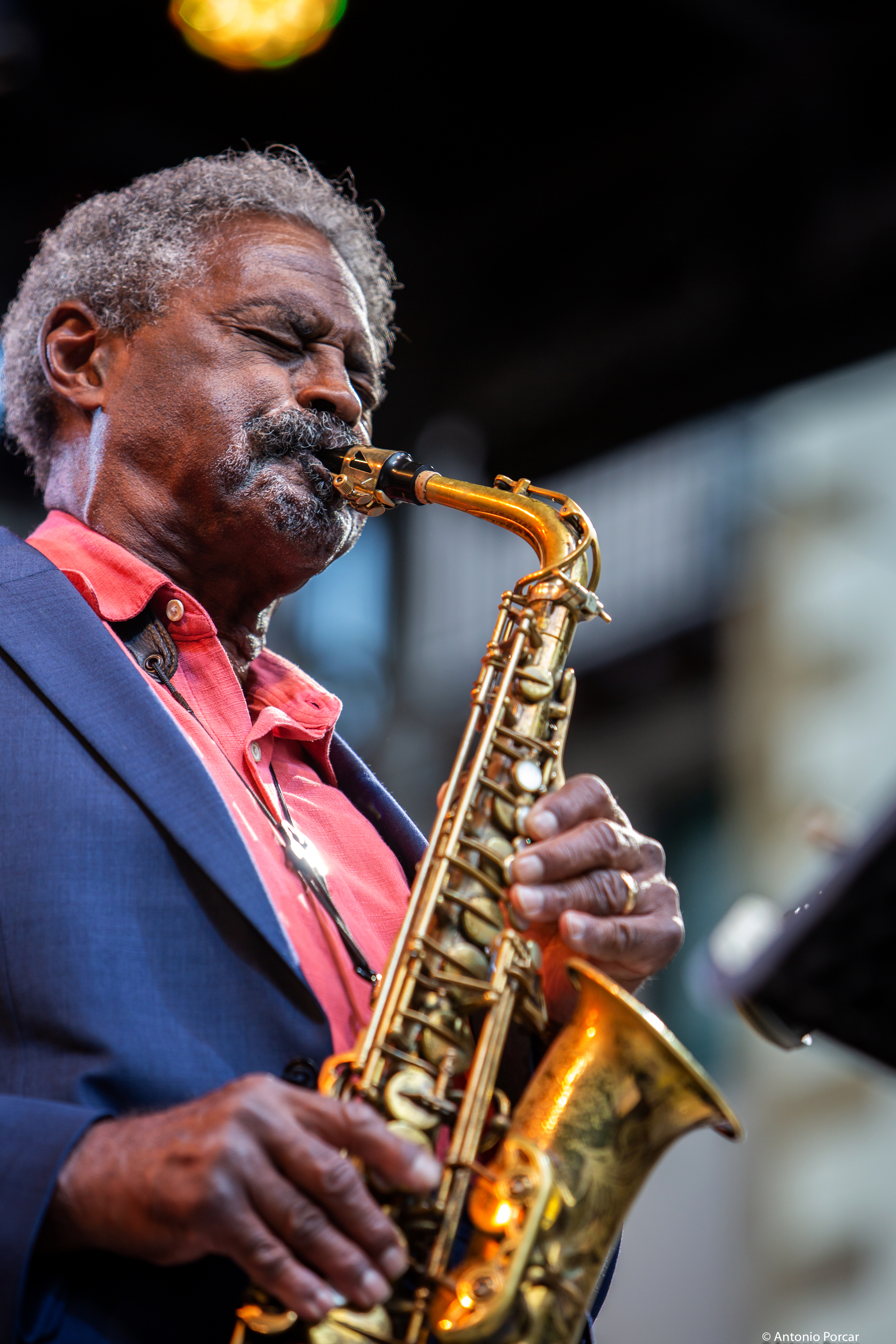Promise – Charles McPherson
One of Charles McPherson’s more modal compositions, with a melody based on fourths, and catchy rhythm section figures. The theme is developed into an intro played by the whole band, which reappears twice in the head and as an interlude between the solos.
- Recording: Charles McPherson - New Horizons
- Recorded on: September 28, 1977
- Label: Xanadu (149)
- Concert Key: E-flat
- Vocal Range: , to
- Style: Swing (medium up)
- Alto Sax - Charles McPherson
- Piano - Mickey Tucker
- Bass - Cecil McBee
- Drums - Freddie Waits
Video
- Description
- Historical Notes
- Solos
- Piano Corner
- Bass Corner
- Drum Corner
- Guitar Corner
- Inside & Beyond
- Minus You
This song is an example of a distinctive ‘60s-70s post-bop style: largely modal, with a simple rhythm section ostinato and a melody based on fourths. The pattern of the five-note melodic theme—alternating a fourth up and a third down—is developed further as an intro, a rising figure doubled by the piano and bass in octaves. This intro figure, two measures long followed by a two-measure drum fill, reappears several times in the head.
The A section repeats the main two-measure theme four times, first twice in E♭ and then twice up a third in G. The following four measures have a melody mostly in dotted quarter notes, outlining a fourth-based Cm7sus structure; the rhythm is doubled by the piano and drums. The last four measures of the first A section are a repeat of the intro. At the end of the second A, this is replaced by four measures of piano and bass tremolos, winding down to B♭7sus for the bridge. The tremolos continue through the bridge, whose melody repeats a three-beat pattern over the barline, using mostly thirds for a contrast with the fourths used on the A section.
The bridge harmonies are four measures of B♭7sus and four measures of B7sus, followed by a four-measure drum fill. The C section is a truncated version of the A section: the first eight measures of A followed by the intro figure with a break to set up the first solo.
Solos are on a form similar to the head, with the rhythm section playing a four-feel on most of the chorus going to “broken time” on the bridge. Both A sections of the solo form end similarly to the second A of the head, while the last four measures of the bridge (a drum fill in the head) hold out B♭7. The C section of the solos is the same as the first eight measures of A. The intro figure is played after each solo, with a break for the next soloist; the drums have the break after the last solo going back to the head. On the recording, the head out is only the first A section; the whole head can be played out instead.
This song’s harmonic structure contains a few passing chords that make it not purely modal, and show a little bit of Charles’ bebop roots. For example, E♭maj7 is connected to Gmaj7 with two beats of D7 at the end of the fourth measure; the first A of the solo section features a “turnaround” at the end, B7 to B♭7 going back to E♭. Less predictable is the Bmaj7 in the eighth measure, breaking up the stretch of Gmaj7.
The A section repeats the main two-measure theme four times, first twice in E♭ and then twice up a third in G. The following four measures have a melody mostly in dotted quarter notes, outlining a fourth-based Cm7sus structure; the rhythm is doubled by the piano and drums. The last four measures of the first A section are a repeat of the intro. At the end of the second A, this is replaced by four measures of piano and bass tremolos, winding down to B♭7sus for the bridge. The tremolos continue through the bridge, whose melody repeats a three-beat pattern over the barline, using mostly thirds for a contrast with the fourths used on the A section.
The bridge harmonies are four measures of B♭7sus and four measures of B7sus, followed by a four-measure drum fill. The C section is a truncated version of the A section: the first eight measures of A followed by the intro figure with a break to set up the first solo.
Solos are on a form similar to the head, with the rhythm section playing a four-feel on most of the chorus going to “broken time” on the bridge. Both A sections of the solo form end similarly to the second A of the head, while the last four measures of the bridge (a drum fill in the head) hold out B♭7. The C section of the solos is the same as the first eight measures of A. The intro figure is played after each solo, with a break for the next soloist; the drums have the break after the last solo going back to the head. On the recording, the head out is only the first A section; the whole head can be played out instead.
This song’s harmonic structure contains a few passing chords that make it not purely modal, and show a little bit of Charles’ bebop roots. For example, E♭maj7 is connected to Gmaj7 with two beats of D7 at the end of the fourth measure; the first A of the solo section features a “turnaround” at the end, B7 to B♭7 going back to E♭. Less predictable is the Bmaj7 in the eighth measure, breaking up the stretch of Gmaj7.
For a more recent Charles McPherson composition with a similar modal post-bop sound, check out The Journey; Charles also has several songs with entirely modal solo sections, such as Fire Dance and Dee Blues . The latter comes from the same album as Promise.
Pianist Mickey Tucker had previously recorded with drummer Freddie Waits on two Willis Jackson albums, “West Africa” in 1973 and “Headed And Gutted” the following year. Tucker recorded quite a lot in 1977, including two Frank Foster big band albums as well as Philly Joe Jones’ “Mean What You Say” and Tucker’s own Xanadu album “Sojourn,” also featuring bassist Cecil McBee as well as trumpeter Bill Hardman.
Pianist Mickey Tucker had previously recorded with drummer Freddie Waits on two Willis Jackson albums, “West Africa” in 1973 and “Headed And Gutted” the following year. Tucker recorded quite a lot in 1977, including two Frank Foster big band albums as well as Philly Joe Jones’ “Mean What You Say” and Tucker’s own Xanadu album “Sojourn,” also featuring bassist Cecil McBee as well as trumpeter Bill Hardman.
Related Songs
Email Send Promise to a friend
Send this page to a friend via email. Add your name or email in the first field. In the second, add one or more email addresses, separated by a comma.

Charles McPherson
born on July 24, 1939
Charles McPherson's new CD, "Jazz Dance Suites" is available. A product of his love and admiration for his daughter Camille, Charles wrote two suites of new music for the CD. Read more...
There was a problem.
...

